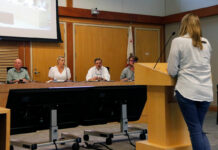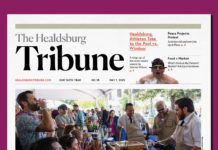My wife Bonnie and I recently visited Boston for the first
time. We toured the Old State House, the seat of colonial and later
state government where the Declaration of Independence was first
publicly read aloud from a second story balcony. We walked along
portions of the Freedom Trail, passed the obelisk at the site of
the Battle of Bunker Hill, and took a bay cruise which passed the
USS Constitution — Old Ironsides. These are the sites and sights
that any first time visitor to Boston must see and wants to
see.
Our hotel was in the Back Bay section of Boston and I took
several walks around the neighborhood visiting three buildings that
I classify as my favorites in any community: a firehouse, a
library, and a church. The firehouse, just half a block from our
hotel, is the home of Ladder 15 and Engine 33. It is the busiest
firehouse in Boston and it is also the oldest. The bay doors of the
apparatus room are too small for a modern engine or ladder truck to
pass through. Rather then modify the appearance of this historical
building, the Boston Fire Department had a truck and an engine
especially designed and built to fit into the house. Not only is
Ladder 15, Engine 33 historic and busy, a neighbor assured me that
it’s the friendliest firehouse in Boston and that I should come
back in the summer when the crews are out on the side walk
barbecuing for the whole neighborhood.
A few blocks to the west is Copley Square. On one side of the
square is the Central Library. The Boston Library, founded in 1848,
was the first publicly supported municipal library in the nation,
the first public library to lend books, and the first to have a
children’s room. The present building was opened in 1895. The
entrance hall and main staircase are at once impressive and
inviting. There are many murals by various American and European
artists, including one by John Singer Sargent called Triumph of
Religion. Of course, there is a room filled with computers,
but, for me the best place, and the very heart of the library, is
the reading room. Bates Hall, named for Joshua Bates, the library’s
first great benefactor, occupies the whole front of the building on
the second floor. High arched windows admit natural light to a
grand room whose walls are lined with floor to ceiling bookcases
and an interior space lined with rows of reading desks. Anyone, at
least anyone who will behave, can come into this wonderful place to
discover and deepen the life of the heart, mind, and soul by
reading, reading, reading.
Facing the library from the opposite side of Copley Square is
Trinity Church. The church was designed by architect Henry Hobson
Richardson and was completed in 1877. It is the birthplace of
“Richardsonian Romanesque,” a style that would be copied in the
U.S. and Europe in many public buildings, not only churches but
schools, railroad stations, libraries, and public utility
buildings. The American Institute of Architects ranks Trinity
Church as among the top 10 buildings in the nation. But for me, on
a cold January morning, it was foremost a place of prayer, a place
to be still and know that God is God, a place to open a Bible and a
Book of Common Prayer and pray Morning Prayer, a place to feel
profoundly at home in a city where I knew no one.
The Healdsburg Fire House, where I was a volunteer for decades;
the Healdsburg Library, where I have read, talked, and argued about
books and ideas since it was housed in the old Carnegie building;
and the churches of Healdsburg, especially St. Paul’s Church where
I preached and prayed for almost 35 years, are places were I feel
profoundly at home in a town where I know lots of people and where
I am blessed with many life sustaining friendships. In the face of
forces of chaos, disintegration and violence in our streets, it
seems to me that these three buildings and the people who build
them, work, volunteer, read, pray, and serve in them, are the very
foundations of sane and healthy civic life. So, when I visit other
cities, if I have the time, I find my way to my three favorite
buildings: a firehouse, a library and a church.
Canon Marvin Bowers is a retired clergyman and may be
reached at frmarvinbowers @gmail.com.








